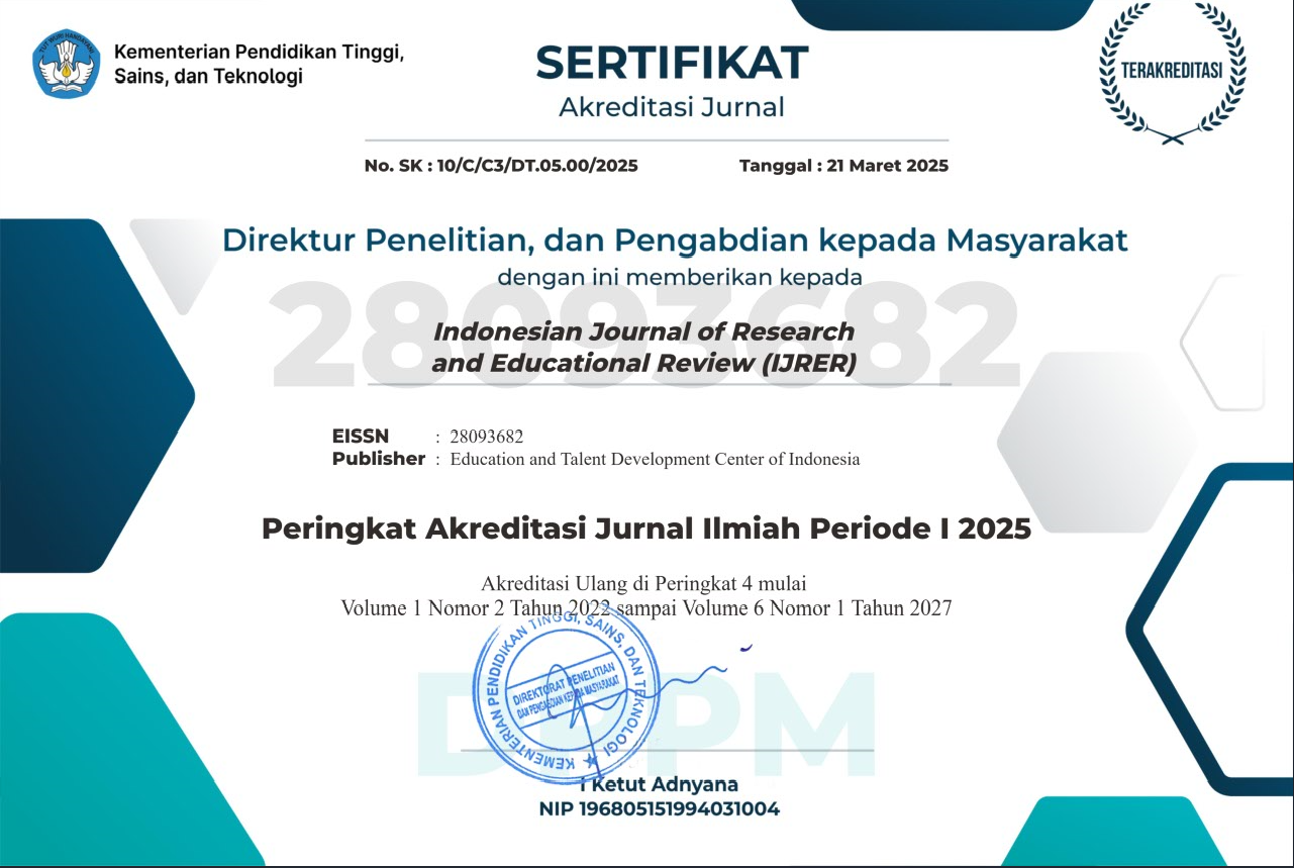The Implementation of Synchronous and Asynchronous Learning in English As Foreign Language Setting
https://doi.org/10.51574/ijrer.v1i1.50
Keywords:
Synchronous, Asynchronous, ImplementationAbstract
The aims of this paper are to provide an understanding to synchronous and asynchronous learning and its implementation in EFL setting. This can be seen from the definition of synchronous and asynchronous learning until the implementation of synchronous and asynchronous learning in EFL setting. This writing is made in the form of a study of documents and literatures whose understanding of knowledge is used as an analysis. The synchronous and asynchronous learning can help the students to enhance language skills. In view of this, the teachers, instructors, and administrators have to consider the students’ need and background knowledge in implementing synchronous and asynchronous learning in teaching EFL.
References
Bower, M., Dalgarno, B., Kennedy, G. E., Lee, M. J., & Kenney, J. (2015). Design and implementation factors in blended synchronous learning environments: Outcomes from a cross-case analysis. Computers & Education, 86, 1-17. https://doi.org/10.1016/j.compedu.2015.03.006
Buelow, J. R., Barry, T., & Rich, L. E. (2018). Supporting learning engagement with online students. Online Learning, 22(4), 313-340. https://doi.org/10.24059/olj.v22i4.1384
Chang, C. F. (2009). Peer review through synchronous and asynchronous CMC modes: A case study in a Taiwanese college English writing course. The JALTCALL Journal, 5(1), 45-64.
Chen, Y., Liu, C., & Wong, R. (2007). The adoption of synchronous and asynchronous media in the teaching of a second language. Issues in Information Systems, 3(1), 217-223. https://doi.org/10.48009/1_iis_2007_217-223
Ene, E., & Upton, T. A. (2018). Synchronous and asynchronous teacher electronic feedback and learner uptake in ESL composition. Journal of Second Language Writing, 41, 1-13. https://doi.org/10.1016/j.jslw.2018.05.005
Friska, Y. (2021). INDONESIAN EFL STUDENTS’PERCEPTIONS ON SYNCRHONOUS AND ASYNCHRONOUS E-LEARNING. Journal of English Language Education, 6(1), 44-55. Retrieved from https://jele.or.id/index.php/jele/index
Garrison, D. R., & Cleveland-Innes, M. (2005). Facilitating cognitive presence in online learning: Interaction is not enough. The American journal of distance education, 19(3), 133-148. https://doi.org/10.1207/s15389286ajde1903_2
Ho, M. C., & Savignon, S. J. (2007). Face-to-face and computer-mediated peer review in EFL writing. CALICO journal, 269-290.
Han, H. (2013). Do nonverbal emotional cues matter? Effects of video casting in synchronous virtual classrooms. American Journal of Distance Education, 27(4), 253-264.. https://doi.org/10.1080/08923647.2013.837718
Hyder, K., Kwinn, A., Miazga, R., Murray, M., Holcombe, D., Clark, R., & Rossett, A. (2007). Synchronous e-Learning The eLearning Guild’s Handbook on The eLearning GuildTMAdvisory Board The eLearning Guild’s Handbook on Synchronous e-Learning i. Retrieved from www.elearningguild.com
Karaaslan, H., Kilic, N., Guven-Yalcin, G., & Gullu, A. (2018). Students’ reflections on vocabulary learning through synchronous and asynchronous games and activities. Turkish Online Journal of Distance Education, 19(3), 53-70.. https://doi.org/10.17718/tojde.444640
Muzaini, M., Rahayuningsih, S., Nasrun, N., & Hasbi, M. (2021). CREATIVITY IN SYNCHRONOUS AND ASYNCHRONOUS LEARNING DURING THE COVID-19 PANDEMIC: A CASE STUDY. AKSIOMA: Jurnal Program Studi Pendidikan Matematika, 10(3), 1722-1735. http://dx.doi.org/10.24127/ajpm.v10i3.3897
Oztok, M., Zingaro, D., Brett, C., & Hewitt, J. (2013). Exploring asynchronous and synchronous tool use in online courses. Computers & Education, 60(1), 87-94. https://doi.org/10.1016/j.compedu.2012.08.007
Park, Y. (2011). A pedagogical framework for mobile learning: Categorizing educational applications of mobile technologies into four types. International Review of Research in Open and Distributed Learning, 12(2), 78-102.
Pattnayak, J., & Pattnaik, S. (2016). Integration of web services with e-learning for knowledge society. Procedia Computer Science, 92, 155-160. https://doi.org/10.1016/j.procs.2016.07.340
Perveen, A. (2016). Synchronous and asynchronous e-language learning: A case study of virtual university of Pakistan. Open Praxis, 8(1), 21-39. https://doi.org/10.5944/openpraxis.8.1.212
Pullen, J. M., & Snow, C. (2007). Integrating synchronous and asynchronous internet distributed education for maximum effectiveness. Education and Information Technologies, 12(3), 137-148. https://doi.org/10.1007/s10639-007-9035-7
Riwayatiningsih, R., & Sulistyani, S. (2020). The Implementation of Synchronous and Asynchronous E-Language Learning in EFL Setting: A Case Study. JURNAL BASIS, 7(2), 309-318.
Shahabadi, M. M., & Uplane, M. (2015). Synchronous and asynchronous e-learning styles and academic performance of e-learners. Procedia-Social and Behavioral Sciences, 176, 129-138. https://doi.org/10.1016/j.sbspro.2015.01.453
Singh, H. (2021). Building effective blended learning programs. In Challenges and Opportunities for the Global Implementation of E-Learning Frameworks (pp. 15-23). IGI Global. Retrieved from http://BooksToRead.com/framework
Stroud, R. (2014). Utilizing Existing Classroom Technology to Enhance Student Engagement. Kwansei Gakuin University Humanities Review, 18, 35-47.
Swan, K. (2002). Building learning communities in online courses: The importance of interaction. Education, Communication & Information, 2(1), 23-49. https://doi.org/10.1080/1463631022000005016
Tabak, F., & Rampal, R. (2014). Synchronous e-learning: Reflections and design considerations. International Journal of Education and Development using ICT, 10(4).
Yamagata-Lynch, L. C. (2014). Blending online asynchronous and synchronous learning. International Review of Research in Open and Distributed Learning, 15(2), 189-212.


























